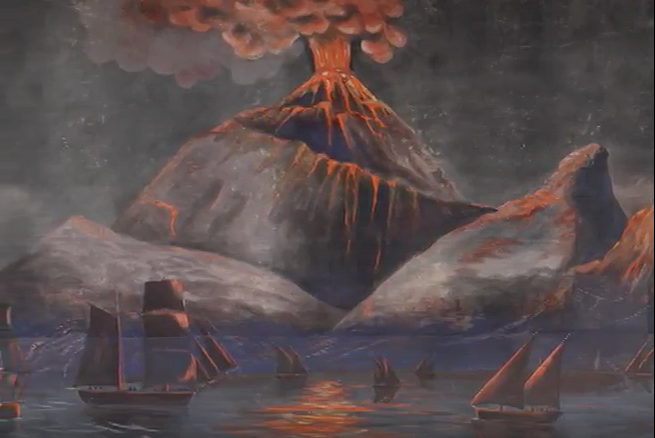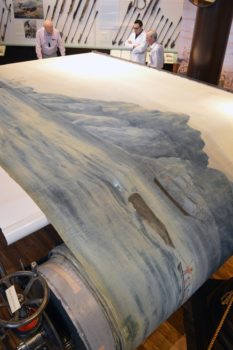[ad_1]

Benjamin Russell and Caleb Purrington, The Grand Panorama of a Whaling Voyage ‘Round the World (detail), ca. 1848, tempera on cotton sheeting.
COURTESY NEW BEDFORD WHALING MUSEUM
On July 14, an artwork equal in length to 14 blue whales placed in a line will go on display in its entirety for the first time in more than half a century. Incidentally, those colossal creatures are central to the work. At 1,275 feet long, the Grand Panorama of a Whaling Voyage ‘Round the World, which was painted in 1848 in New Bedford, Massachusetts by Benjamin Russell, an artist and merchant, and Caleb Purrington, a sign painter, is the longest painting in North America, according to the New Bedford Whaling Museum, which is staging the work’s big return.
The sprawling piece—which was conceived in five separate segments—was donated to the museum in 1918 by Benjamin Cummings, a grocer in New Bedford whose acquisition of the Panorama remains mysterious. In 1972, Philip F. Purrington, a curator at the New Bedford Whaling Museum, wrote that Cummings’s “possession of the paintings seemed of such casual interest that no record exists of when or how he came to acquire them.” According to the museum’s curator of maritime history, Michael Dyer, it’s possible that his decision to give the work was informed by a need to better preserve and store the massive Panorama.
Over the last three years, it has undergone extensive restoration work, having damage that it incurred over its action-packed life repaired. During the mid-19th century, the Panorama traveled to cities around the country—Boston, New York, and St. Louis, to name a few—and was exhibited as a lively, cinematic experience, often narrated by Russell himself over the course of a two-hour performance. The spools of painted cotton sheeting that comprise the work were furled and unfurled, revealing rich scenes of far-flung wonders, seen by Russell while working as a steerer on the Kutusoff, which set sail from New Bedford in 1841 and returned in 1845. The ship traveled to New Zealand, Tahiti, Cape Horn, and the Hawaiian Islands, among other distant locations, and Russell, entangled in many debts, created the fanciful Panorama with the hope that it could function as a commercial attraction. Audience members for these displays were “armchair travelers,” as Christina Connett, the Whaling Museum’s chief curator, put it.
The gargantuan painting includes detailed information about “natural history, maritime history, and architectural history,” Connett said. “There are so many narratives within it. . . . And it was a way for people to experience places they probably never would have visited in their lifetimes.”
Four segments of the work remain today—the fifth, depicting the voyage’s course from Fiji to St. Helena, was lost at least 100 years ago, before it came into the hands of the museum.

Benjamin Russell and Caleb Purrington, The Grand Panorama of a Whaling Voyage ‘Round the World (detail), ca. 1848, tempera on cotton sheeting.
COURTESY NEW BEDFORD WHALING MUSEUM
The artwork will be on view through October 8 at Kilburn Mill, an old textile mill in New Bedford, and, starting July 29, the museum itself will showcase a life-sized video projection of the scroll (constructed from detailed photographs taken during the conservation) that will be viewable from, among other vantage points, the deck of the Lagoda, a whaling ship contemporaneous to the Panorama that is part of the Whaling Museum’s collection. Connett said that this presentation, which will feature a recreation of the original narrative that accompanied the curio as it was reeled across stages, conveys the sense of dramatic spectacle that was at the heart of the work’s 19th-century appearances.
It was “an age of interest in the world getting smaller and people being able to experience that—from a Western gaze,” she said. “And this was how the rest of the world was represented to them.”
With its nearly quarter-mile-long berth, the Panorama depicts a remarkable range of places, as well as the many moods of the open ocean. The volcano Fogo on Cape Verde erupts before a fleet of ships, casting a grey and purple pall across the sky and sea; the verdant landscapes of the Azores and Rio de Janeiro explode with life; threatening rock formations emerge from a roaring, tempestuous sea; placid harbors border colonial villages with buildings stacked atop one another.
The Panorama was last seen in full in 1961 in a New Bedford grocery store, and was shown in part at the 1964 World’s Fair in New York in the New England pavilion, but then faded into relative obscurity. Connett said that the behemoth had recently been rediscovered in the museum’s basement, where a curator had apparently hidden it to protect it from the whims of a prior museum director, who considered it an “albatross.”
After decades sitting in storage, the work may again have a chance to travel. Connett is considering venues on the East Coast that could potentially host the Panorama, and said that future showcases—which could run from 2019 to 2020—will enable curators and viewers to rethink and reimagine the hulking work in different ways.
“My goal is that, at each site that’s hosting the Panorama, we would have the opportunity to reinterpret it according to the strengths of that institution,” she said.
The museum is also working to find a permanent home for the Panorama, and Connett said that such a display in New Bedford is not out of the question. The coastal Massachusetts town is, after all, where the whole adventure began.
[ad_2]
Source link

